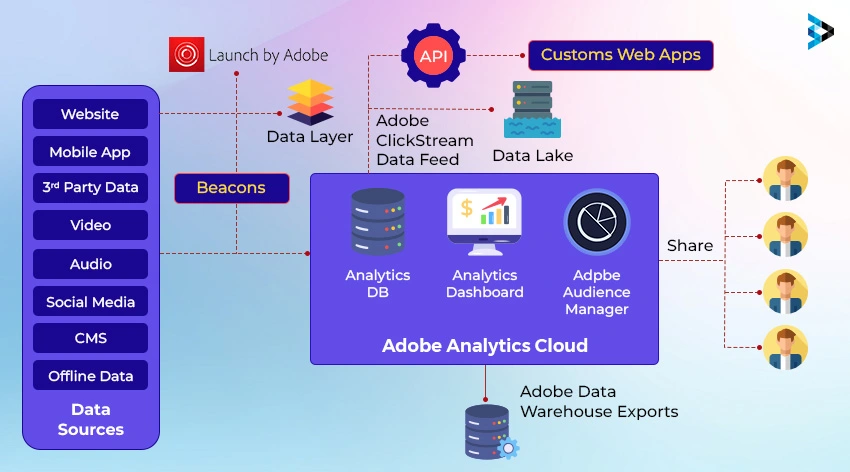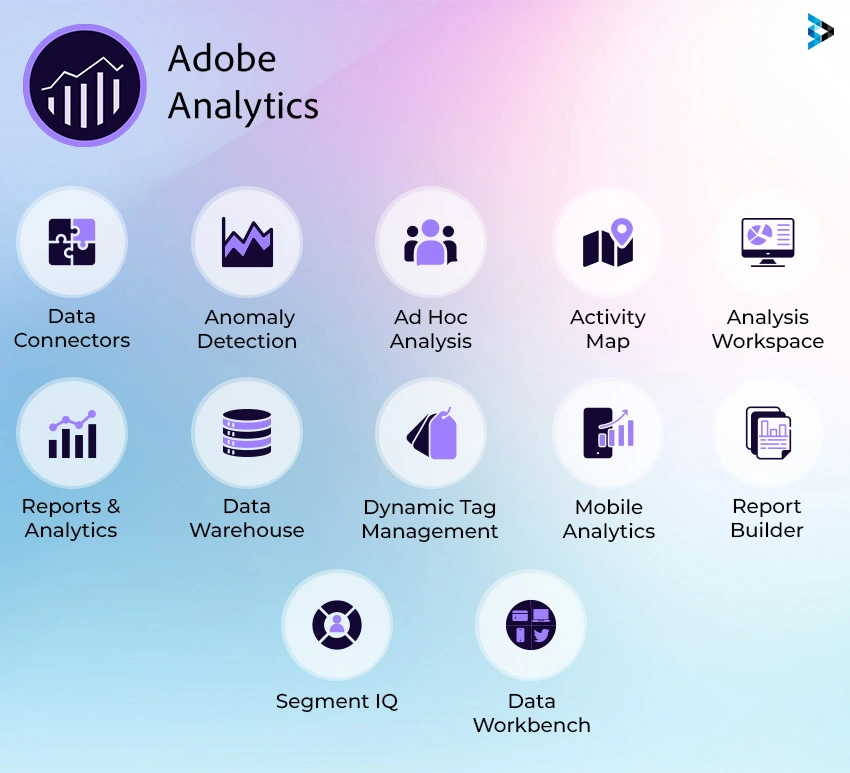Both technology and shopping trends are always in a state of constant evolution. Any company that doesn’t adapt to these changes is bound to see failure in the long run. Now the question is, how can they keep up? Well, they need to utilize accurate data insights or eCommerce analytics to predict market changes. And when it comes to eCommerce analytics, Adobe Analytics is surely an epitome. Below, we will see how Adobe Analytics can come in handy while making the best possible decisions for your business.
What is eCommerce Analytics?
eCommerce analytics is the process of accumulating data from all of the areas that have an impact on your store. You should then utilize this data to understand shifts in customer behavior and online shopping trends.
A survey conducted by Forbes indicates that 53% of internet buyers search for firms that can personalize their needs. As a result, the absence of accurate personalization on your website may make you lose many prospects. By leveraging effective data analysis, you can understand your customers better. Plus, it makes way for better marketing and increased revenue.
Web analytics today takes all that’s great about modern data science, including complex segmentation, predictive tools, real-time reporting, etc., and applies it to the original digital channel. This allows you to get valuable insights that drive the decisions that aid your customers as well as your bottom line.
Adobe Analytics: Your Reliable Companion For Precise Market Change Estimation
Introducing Adobe Analytics tailored specifically for your website’s business requirements. It is a part of the Adobe Experience Cloud and gathers multichannel info about how your customers interact with various properties. This is useful for obtaining detailed reports to figure out product success, user-brand interactions, and more.
Adobe Analytics is more than just a tool for providing simple metrics. With the addition of machine learning, artificial intelligence, and other forms of modern data analysis, it has become the ace in web analytics technology, providing more accurate customer insights faster than ever. Interestingly, Adobe Analytics is known for collecting the necessary data from multiple sources. These include web and mobile applications, websites, Adobe Experience Cloud apps, and so on. Additionally, it relies on several third-party apps like Customer Data Platforms (CMP), Data Management Platforms (DMP), etc.

Why does Adobe Analytics matter this much?
Adobe Analytics lets you match, analyze and mix data from any digital point in customer journey. Adobe Analytics comes with comprehensive analysis, diverse reports, and intelligent predictions. This gives you precious insights to ensure a robust CX. There are four main aspects it focuses on to give you the finest results possible – web analytics, marketing analytics, attribution, and predictive analysis.
Adobe Analytics lets you get real-time insights to check for the most actionable, deepest views into helping customers.

How to Integrate Adobe Analytics With eCommerce?
You can integrate your eCommerce website with Adobe Analytics regardless of technology.
- Purchase Adobe Analytics license: Adobe Analytics becomes available for use only after you create an Adobe account and get the required licensing. There is no pricing for Adobe Analytics publicly available on their official site. The pricing is dependent upon your website traffic.
- Adobe Connector integration with eCommerce website: Adobe Experience Platform lets users obtain Adobe Analytics data via the Analytics Source Connector. It allows the real-time streaming of Analytics data to Platform. This helps transform the SCDS-formatted Analytics data into XDM fields consumable by Platform. Partnering with an AEM partner can further optimize this integration, ensuring seamless data flow and enhanced digital experiences. After a source connection is ready to roll, data fields will be auto-mapped and ingested into the Real-Time Customer Profile—and that too, within a short time.
- Configure your dashboard: Setting up the dashboard properly is a must for anyone wanting to use Adobe Analytics effectively. Create a dashboard by following these steps: Component > Dashboard > Add Dashboard and name it. Once it is added, configure the dashboard by selecting the 2×2 layout, clicking on ‘Add Content,’ dragging and dropping your reports, and adding pages as needed. Also, don’t forget to hit ‘Save.’
Key features of Adobe Analytics
Let us now see some of the most sought-after features you get when you hire an Adobe Commerce developer for Adobe Analytics integration:
| Feature | How it helps |
| Real-Time Data Collection and Reporting | Adobe Analytics collects data from lots of different sources, such as web, email, mobile devices, web-based kiosks, client-server apps, and whatnot. Its real-time reporting is useful for businesses in keeping track of key metrics and trends as they occur. Needless to say, it aids businesses in agile decision-making and responding promptly to the ever-changing market. |
| Comprehensive Data Analysis | Adobe Analytics’ Data Analysis is not only robust but also comprehensive. It collects data from a large number of digital channels and analyzes them thoroughly. The insights derived from such analysis are then used for better marketing campaigns and enhanced customer experiences. More detailed insights mean more customization at scale for your customers. |
| Cross-Device and Cross-Channel Tracking | Adobe Analytics gives users the gift of Cross-Device and Cross-Channel Tracking. Cross-Device Analytics (CDA) is helpful in detecting cross-device visitors and thereby turning the device-centric view into a person-centric view. Naturally, analysts become capable of understanding customer behavior regardless of the browser, device, or app they are using. It also offers Cross-Channel Analytics (CCA). CCA is a powerful way to combine and run reports from various datasets from various channels. The person’s ID acts as a common identifier here and businesses get to figure out customer journeys with ease. |
| Advanced Segmentation and Targeting | Adobe Analytics’ Segmentation IQ feature is pretty solid. It makes it easy to find statistically important distinctions among endless segments. It relies on automated analysis of all the metrics and dimensions. This helps businesses get a great idea of the major characteristics of the segments responsible for driving their Key Performance Indicators (KPIs). As the segmentations are real-time, ML algorithms efficiently predict customer churn, conversion possibility, etc. Needless to say, this comes in handy during remarketing. Plus, its behavior visualizations help you customize your site to best cater to your customer’s needs and preferences. Also, its advanced targeting helps you create tailored experiences for individual customers according to their demographics, past interactions, behavior, and more. |
| Predictive Analytics | Predictive Analytics uses ML algorithms and advanced statistical modeling for customer data analysis. After that, it makes predictions regarding customer churn and conversion likelihood. This enables businesses to capitalize on large datasets that may otherwise go to waste. By tapping into these huge datasets, companies get to discover patterns that disclose valuable customer insights and make more informed decisions. |
| Integration with Adobe Experience Cloud | What elevates Adobe Analytics more is its seamless integrations with other Adobe Experience Cloud solutions. These include Campaign, Target, Mix Modeler, Commerce, etc. Why does this matter? Well, this makes it possible for businesses to collect and stitch data from various sources. Having such a unified view of their customer journey gives businesses a massive convenience boost. By harnessing the strength of a complete ecosystem, businesses become capable of offering more tailored and consistent Adobe B2B commerce (or B2C) experiences no matter the channel. |
| eCommerce and Revenue Tracking | Adobe Analytics’ eCommerce Tracking is a robust way to monitor the business impact of an online store. It helps you gather important metrics like conversion rate, customer lifetime value, customer engagement, session duration, bounce rates, and so on. This helps businesses in figuring out customer behavior, ROI, sales performance, etc., and make better strategies to improve sales, decrease costs, and whatnot. On the other hand, the ‘Revenue’ metric is helpful for eCommerce sites in knowing the monetary amount of all products bought from the store. Measuring conversions was never easier! One can easily view the dimension items that contributed to the revenue, such as top campaigns (by utilizing tracking code) and top internal search terms (by utilizing an eVar) among others. |
| Customization and Extensibility | Adobe Analytics excels at two things – one is customization, and the other is extensibility. Yes, Adobe Analytics has no parallels in these fields, and it shows. The tool is customizable based on a business’ specific needs. Already sounds amazing, right? Wait, that’s not all! Businesses can integrate the tool into their existing workflows easily. Also, its awesome extensibility cuts the time, effort, and cost manifold while integrating new services/features. |
| Actionable Insights and Recommendations | Adobe Analytics doesn’t only deliver canned reports. Instead, it provides actionable insights from all digital customer interactions. By combining data from multiple channels and stages of the customer journey, it helps build audiences and segments that really matter. Actionable insights are your best bet in knowing your customers – their preferences, their buying journey from stage to stage, and more. Plus, you can identify bottlenecks in your customer journey and take steps to fix them. Additionally, you can compare specific demands in certain customer reviews with high-value/repeat customers and see if they align with each other. If yes, you can utilize this insight to introduce new product variants. Using the view/purchase-based behavioral data from Adobe Analytics, one can create criteria in Target Recommendations to define what products to recommend without hassle. |
If you are still hesitant to opt for Adobe Commerce development, check out these Adobe Analytics usage stats in different industries. See how popular it is?

Adobe Analytics vs Google Analytics
Adobe Analytics is often compared with Google Analytics for its capabilities, features, and effectiveness in helping businesses in understanding their digital performance. But the former emerges as the clear winner over the latter for several reasons, even though both platforms are valuable in terms of the insights they provide:
- Advanced Enterprise-Grade Features: Adobe Analytics comes equipped with advanced enterprise-grade features like advanced calculated metrics, context-aware sessions, the ability to capture more data points, increased reporting transparency, better boilerplate data collection, and more. Everything is more in-depth with Adobe Analytics.
- Seamless Integration with Adobe Experience Cloud: Adobe Analytics gets easily integrated with other Adobe Experience Cloud solutions. Some of them are Target, Commerce, Campaign, and so on. This paves the way for a more comprehensive solution utilizing all available avenues to give customers what they are looking for.
- Customization and Extensibility: Companies are able to tailor the tool to suit their unique requirements and include it in their present processes, since they have control over it to make it fit into what they are already doing. In addition, it highly minimizes the costs, time, as well as energy demands that would have been needed while incorporating new services or functionalities from Adobe Commerce Cloud.
- Data Privacy and Compliance: Adobe Analytics strictly complies with General Data Protection Regulation (GDPR). It is a law that ensures the protection of data in the EU. It helps businesses adhere to GDPR and preserve consumers’ data privacy, simultaneously being GDPR-compliant toolkit.
Conclusion
Businesses can unleash the complete potential of their data, propel growth, nurture loyalty, and reach awesome heights in the hyper-competitive world of eCommerce when they use Adobe Analytics. Use the features of Adobe Analytics to launch a new era powered by data-based decisions and unique creativity. Contact us to set up Adobe Analytics on your website!
[ Read More : Migrate Your eCommerce store to Shopify Plus ]
FAQ
Adobe Analytics comes with Adobe Experience Cloud. It is a tool that lets users mix, match, and analyze data from a certain digital touchpoint on a customer journey.
One word: features. Yes, Analytics comes with robust features like transparent reporting, extensive customizability, smooth integration with other Adobe Experience Cloud solutions, Segment IQ, cross-device/cross-channel tracking, and whatnot. A true revolutionary in this field!
Buy a license first, then integrate Adobe Connector with your website, and set up your dashboard for a sleek Analytics experience.
Adobe Analytics suits various businesses and can help them step up their game. Be it construction, retail, IT, hospitality, or something else – Analytics can be your best companion.
Yes, it can be. That’s what makes Adobe Analytics what it is. You can incorporate Analytics into your eCommerce site regardless of the system or platform.
Related Articles
-
10 Pain Points Of eCommerce Customers and Their Possible Technology Solutions
The $5.2 trillion eCommerce market has altered the retail industry, providing consumers with flexibility in shopping. E-commerce development is not without its challenges, and customers can experience pain points such
-
Node.js, PHP or Java: Which One Should You Choose for Web Development
Node.js, PHP, and Java – the debate continues! It’s almost impossible to end this debate on a concluding note. Why are we saying this? The debate is – Which of
-
5 Reasons to Choose nopCommerce For Your Next eCommerce Development Project
Talking About 5 Reasons to Choose nopCommerce For Your Next eCommerce Development Project, In a world where netizens are growing with time, eCommerce has become a business need. To cater




